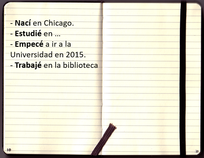 There is no way to avoid the issue of the stress marks (acentos) when talking about spelling in courses of Spanish for Heritage Language Learners. Many students and teachers will agree that this is one of the most difficult aspects of spelling to learn. And it is! In order to place the stress mark in the right place, the writer needs to:
And ... do all this in the back of your head while you think of more important things, such as the ideas you want to express. And do so very quickly, because you need to move on to the next word. However, as many students, teachers, and researchers have noticed, the process stops at the second step, when students cannot identify the stressed syllable of the word. Dr. María Carreira, a professor of Spanish Linguistics at Cal State University Long Beach, explained that the problem is not that the students lack the ability to perceive stress, but rather that they seem unable to access this implicit perception and turn it into an explicit identification. It makes sense. If the student didn't know (implicitly) what the stressed syllable was, they would not pronounce the word right. And that's not the case. Dr. Carreira trained the students into improving their ability to locate the stressed syllable of a word, by making them listen recordings of words in which the stressed syllable was read with an amplified pitch, length, and loudness. Dr. Sara Beaudrie, another professor and researcher I have mentioned before in this blog, also conducted a study in which she trained students to identify the syllable before the rules where introduced. I want to suggest here an alternative (or, rather, complementary) manner to address stress marks in the classroom: study groups of words that are related and that follow the same pattern. For example, the past tense (preterit) for yo and él / ella: such as: nací, crecí, vivió, nació, creció, vivió, empezó, estudió, etc. (Regular verbs only). Students, by themselves or in groups, can write autobiographies or someone else’s biography, and work with those forms. Other groups of words that share a stress pattern while sharing some communicative functions are:
Working on each of these groups has the following benefits:
That said, identifying the stressed syllable, learning the rules, and even grouping words into patterns, will not be enough. Adding the stress mark to a word has to become automatized enough so that the student can do it while focusing on something else. As with many other aspects of language, we need to distinguish between competence and performance. While a student might know where and where to write the accents (competence), they might not do it every time they write something (performance). As tempting as it might be to repeat the rules over and over, students should be given the opportunity to practice placing the stress marks so that it becomes an automatic task that does not require any thinking. References: Beaudrie, S (2017). The Teaching and Learning of Spelling in the Spanish Heritage Language Classroom: Mastering Written Accent Marks. Hispania, 100, 4. Carreira, M. (2002). When phonological limitations compromise literacy: A connectionist approach to enhancing the phonological competence of heritage language speakers of Spanish. In S. Hammadou (Ed.), Literacy and the second language learner. Greenwich, CT: IAP. *********************** Have you encountered any interesting spelling error (frequent or not) you would like me to write about? Feel free to let me know in a comment.
1 Comment
9/6/2020 07:45:46 am
I love to learn the Spanish language for its diversity. As I am a learner of this language, it helps me a lot.
Reply
Leave a Reply. |
BLOG ON SPELLING
This is a blog about spelling in Spanish Heritage Language Learners. Some posts will be in Spanish and some in English. Feel free to ask your questions in the comments section.
Archives
September 2023
Popular Posts
Made-up words and other fipers. Tips for teaching stress marks. Los hablantes nativos y la ortografía |



